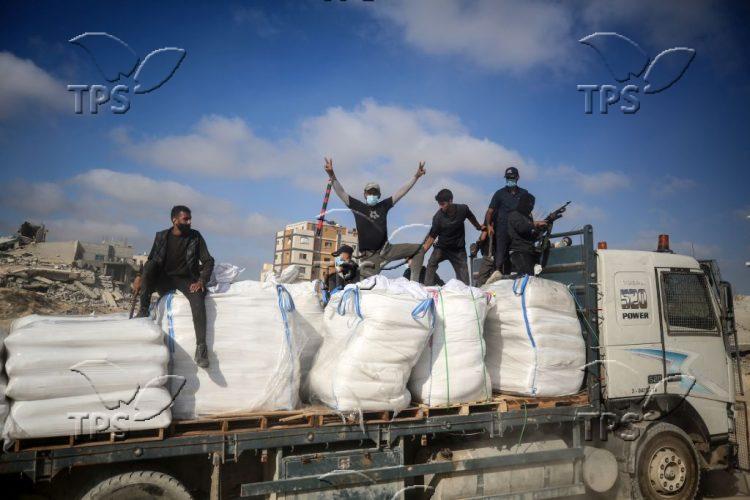Jerusalem, 31 July, 2025 (TPS-IL) — Central to the international pressure on Israel for a ceasefire with Hamas are claims of widespread starvation and even accusations that Israel is deliberately using hunger as a weapon. But The Press Service of Israel’s closer examination of the humanitarian aid pipeline found that a combination of United Nations policies, Hamas looting, and black market profiteering prevents much aid from reaching Gaza civilians and inflates the prices of items that do reach market shelves, writes TPS.
Most damningly, according to the UN’s own numbers, a staggering 85% of the aid entering the Gaza Strip by truck since May 19 has been stolen.
“There is some hunger in Gaza, and it exists only in places Hamas is pursuing it, not in other areas,” said Professor Eytan Gilboa an expert in international relations and media at Reichman University in Herzliya.
UN Bottlenecks and Bad Assumptions
Recent data suggests that Israel continues to facilitate large-scale humanitarian aid to the Gaza Strip — far exceeding pre-war levels. According to a July 2025 report by the Begin-Sadat Center for Strategic Studies, claims of deliberate starvation are not supported by facts on the ground.
Before the war, around 150–300 trucks entered Gaza daily, though only a fraction carried food. Data from the UN Office for the Coordination of Humanitarian Affairs (OCHA) shows that in 2022, an average of 292 trucks crossed daily, with just 73 of them carrying food — around 25%. Despite this, there were no signs of famine. Public health indicators such as infant mortality and life expectancy matched those in Jordan and Judea and Samaria.
The report also refuted flawed assumptions about local food production. While Amnesty International claimed that local agriculture provided 44% of Gaza’s food needs, the report argued that this number was based on financial expenditure, not caloric intake. In reality, local production accounted for no more than 12% of caloric supply. The majority of calories came from imported grains, oils, and food aid — largely delivered by the UN Relief and Works Agency (UNRWA) and the World Food Programme.
Israel suspended aid shipments temporarily in March 2025 due to Hamas’ systematic looting, but resumed deliveries in May. By the end of May, 170 trucks were entering the Strip each day. As of July 27, 2025, all aid crossings have reopened, and additional airdrops are being carried out. The Gaza Humanitarian Fund (GHF), launched in May, now supports alternative aid distribution networks.
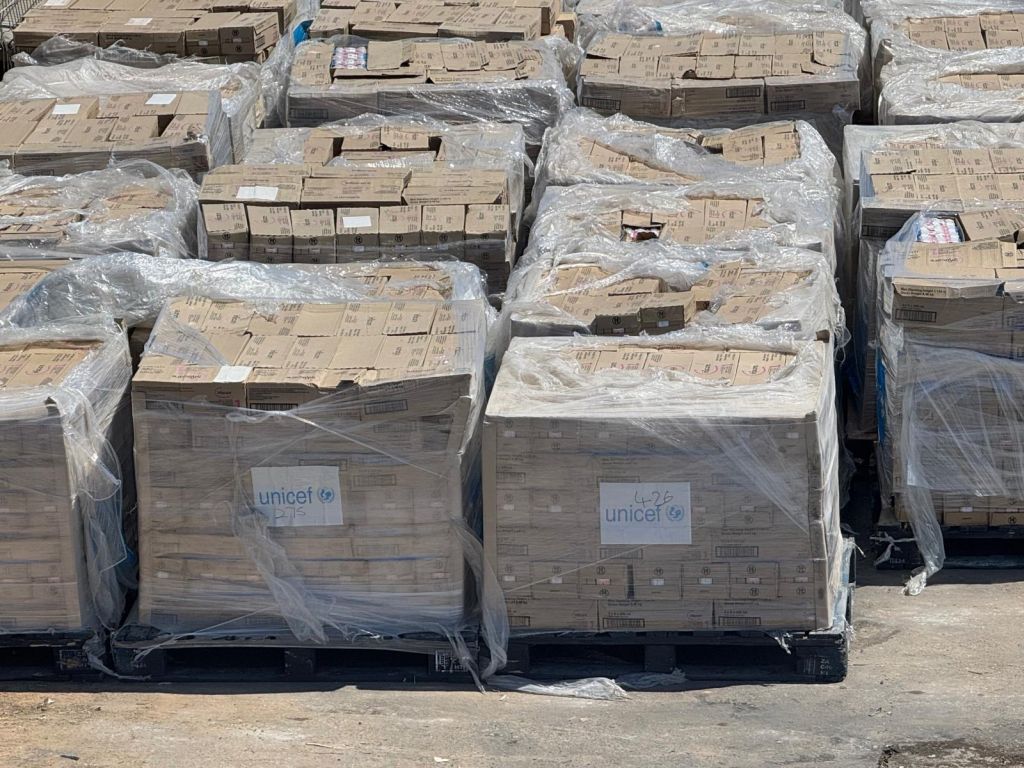
Hundreds of pallets of undelivered, vetted UN aid sitting in the sun at the Kerem Shalom border crossing with Gaza on July 25, 2025. Photo by COGAT/TPS-IL
According to official Israeli sources, humanitarian aid currently flows through two main channels. The first includes direct food packages — primarily shelf-stable items such as canned vegetables, lentils, and nutritional supplements — distributed by international organizations through secure hubs.
The second channel involves community-level solutions such as bakeries and communal kitchens, operated by the World Food Programme and non-governmental organizations like World Central Kitchen, using vetted local partners to deliver cooked meals.
As of July 24, the number of trucks at the Kerem Shalom border crossing waiting for pickup by international relief organizations was reportedly more than 800. In an email response to questions from TPS-IL, a UN spokesperson attributed the delay to strict Israeli security protocols. “Kerem Shalom isn’t a walk-up warehouse,” the spokesperson said.
“For 11 weeks, the Israeli authorities blocked the entry of any items – regardless of how critical they were for civilians’ survival. So, images of supplies piling up inside closed, militarized compounds in fact show what aid workers have not been facilitated in collecting and delivering,” she wrote.
But legal expert Anne Herzberg blames the UN for the necessity of time-consuming inspections. She told TPS-IL that the UN knew that Hamas was using the aid convoys to smuggle weapons but turned a blind eye to the problem. Herzberg is the legal advisor to NGO-Monitor, a Jerusalem-based non-profit that monitors the activities of non-governmental organizations.
“Had they been more proactive in trying to block weapons smuggling and aid diversion, they wouldn’t need any inspections,” she insisted.
According to the UN’s World Food Program, as of July 25, there was “roughly 3,500 MT [metric tons] of WFP cargo (the equivalent of 300 trucks) ready to be collected from holding areas for collection and distribution inside Gaza.”
The WFP also noted a shortage of truck drivers, saying only 60 have been vetted and approved to make deliveries in Gaza.
An Israeli security source stressed to TPS-IL that collecting and distributing aid is the UN’s responsibility, not Israel’s. “They are not doing their job well. Only when pressure is put on them do they start collecting. We allowed them delegations and time frames and they do not meet the coordinated times, but arrive late and for a few hours,” he said.
“Israel is ready to facilitate and do much more than is required, such as providing logistical assistance, fuel for the trucks, walkie-talkies so they can talk to each other. Just this week we announced humanitarian corridors and tactical truces to facilitate the collection of equipment,” he said.
Hamas’ Manufactured Crisis
Israeli army sources told TPS-IL that the real obstacle to feeding Gaza is Hamas. This accusation is backed by UN figures.
According to data on the website of the UN Office for Project Services (UNOPS), 2,013 trucks carrying 27,464.5 tons of of aid — almost entirely food — entered Gaza since May 19. Of that number, 1,753 trucks carrying 23,353.3 tons of aid never reached their destinations. All 85% of the missing food was designated by the UNOPS as “intercepted” by “either peacefully by hungry people or forcefully armed actors, during transit in Gaza.”
UNOPS is the operational arm of the UN that helps implement humanitarian, development, and peacebuilding projects.
A record 90 trucks carrying 1,695 tons of aid were looted on May 31 alone, according to UNOPS.
The data showed that 98.6% of the stolen aid was food, with the remainder designated as “solid fuel,” nutrition,” and “health.” In addition, 90.3% of the stolen aid belonged to the World Food Program. The remaining aid belonged to World Central Kitchen, the UN Children’s Fund (UNICEF), the International Committee for the Red Cross, and International Medical Corps Gaza.
UNOPS did not refer to Hamas by name, but Israelis and Palestinians did.
“From the start, Hamas has tried to make the humanitarian distribution by GHF fail,” an Israeli military official told TPS-IL. “They intimidate civilians and threaten anyone who approaches aid centers.” The same official confirmed a June incident in which grenades were thrown at American aid workers.
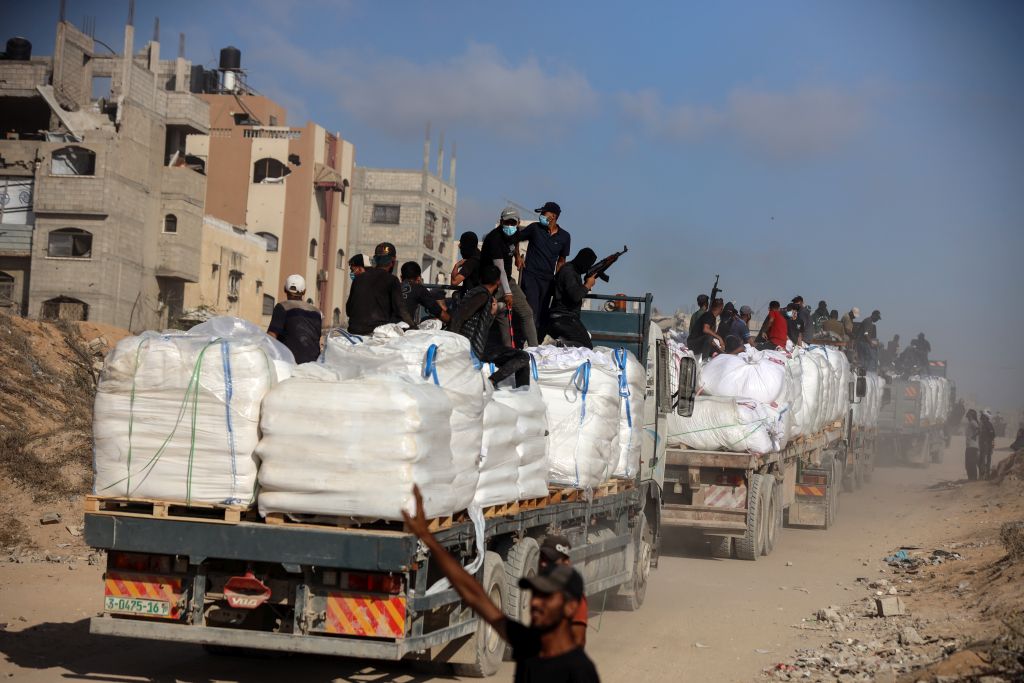
Hamas terrorists carrying clubs and firearms secure humanitarian aid trucks in the northern Gaza area of Jabaliya on June 25, 2025. Photo by TPS- IL
Gaza activist Hamza al-Masri, who runs a popular Telegram channel, wrote, “Every Gazan knows who holds weapons. If someone has weapons, either they are Hamas or they bought them from Hamas. There are no secrets here.” In a comment under the post, a user named Samer Bashir, asked whether the attackers were Hamas. Al-Masri responded: “All the thugs and thieves are Hamas and work for Hamas.”
Videos circulated on July 29th show aid trucks passing through Deir al-Balah while armed men fired into the air to disperse civilians. Eyewitnesses claim the gunmen are affiliated with Hamas. Similar accounts point to the terror group’s systematic interference with humanitarian operations.
The accusations are further is supported by internal Hamas documents seized by Israel, intercepted communications, and verified images. During the initial stage of the war in October 2023, Hamas diverted 25% of all incoming UN aid. By early 2024, this quota was redistributed as follows: 7% to Hamas’ Izz ad-Din al-Qassam Brigades, 4% to Hamas’s civil administration, 4% to the group’s political leadership.
Intercepted documents also reveal the threats against aid workers and deliberate efforts to sow chaos in Gaza’s streets, such as closing markets, stirring unrest, and preventing civilians from reaching distribution points through intimidation or gunfire.
Discussing the army’s roles aid distribution sites, convoys and air drops, Israel Defense Forces spokesperson Brig. Gen. Effie Defrin told reporters on July 27, “Hamas, on the other hand, is actively obstructing the process — stealing aid, storing it in tunnels, and using disinformation to spread the false claim of famine in Gaza.”
Tactics used by Hamas include physically seizing UN trucks, blocking civilian access to aid sites, impersonating aid workers, and inserting operatives into UN convoys. A parallel distribution network has reportedly been established — selling confiscated aid at prices 300–500% above market value, taxing local vendors, and using food control as a political tool.
The situation has reached the point where some humanitarian organizations are reluctant to collect or distribute aid due fear of violence or being seen as cooperating with Israel.
“Hamas’s goal is to get rid of the Gaza Humanitarian Foundation distributing food in Gaza,” said Gilboa. “They want to be the only ones ensuring Gazans’ survival and have been very successful in mounting a campaign portraying hunger everywhere.”
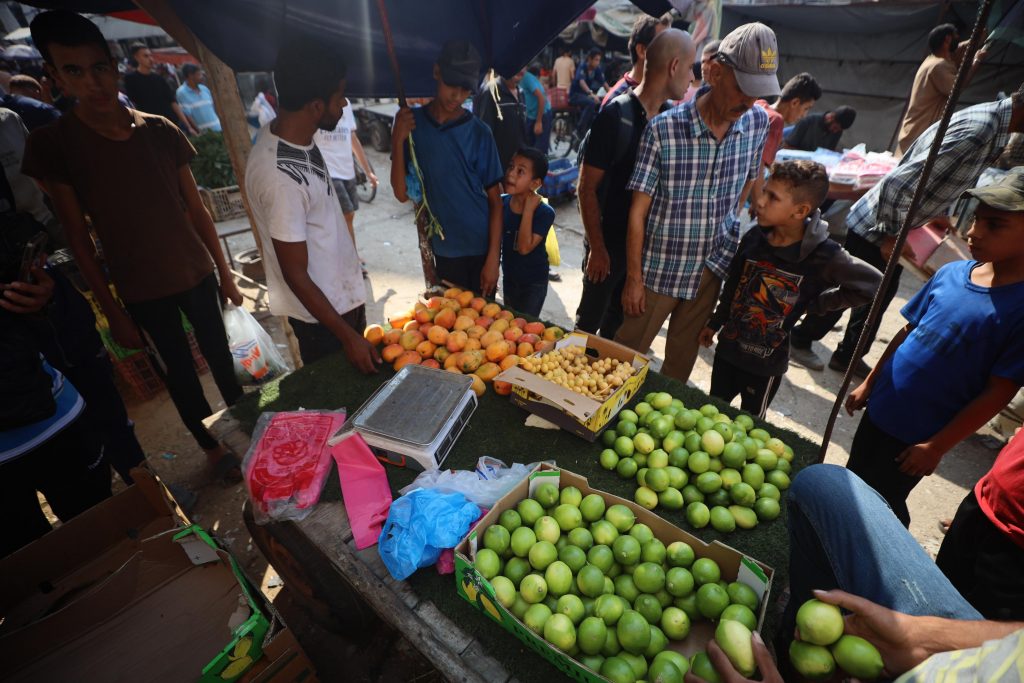
An abundance of food in Gaza City’s al-Sahaba market on July 28, 2025. Photo by TPS-IL
Black Market Profiteering off Donated Food
Despite the surge in aid deliveries, Palestinians in Gaza City’s Al Sahaba market told TPS-IL the prices are too expensive.
“Today I saw fruit for the first time in four months. Mangoes, bananas… but they’re selling them for 200 shekels [$59]. People can’t afford it. We see it, smell it, and walk away,” one Palestinian told TPS-IL on July 28, one day after the airdrops and new aid protocols began. “It’s an injustice and it’s a sin.”
Another woman told TPS-IL how her children ask for fruit they hadn’t tasted in months. “I can’t buy four pieces even for my kids. It’s like a dream on display,” she said.
A third Palestinian told TPS-IL, “The flour — when it enters Gaza, they steal it. And now they’re going to raise the price from 30 to 60 shekels [$8.80 to &17.70]. It’s unbelievable.”
Footage from the market confirmed the disparity: shelves stocked with aid-labeled goods resold at prices unaffordable to the intended civilians.
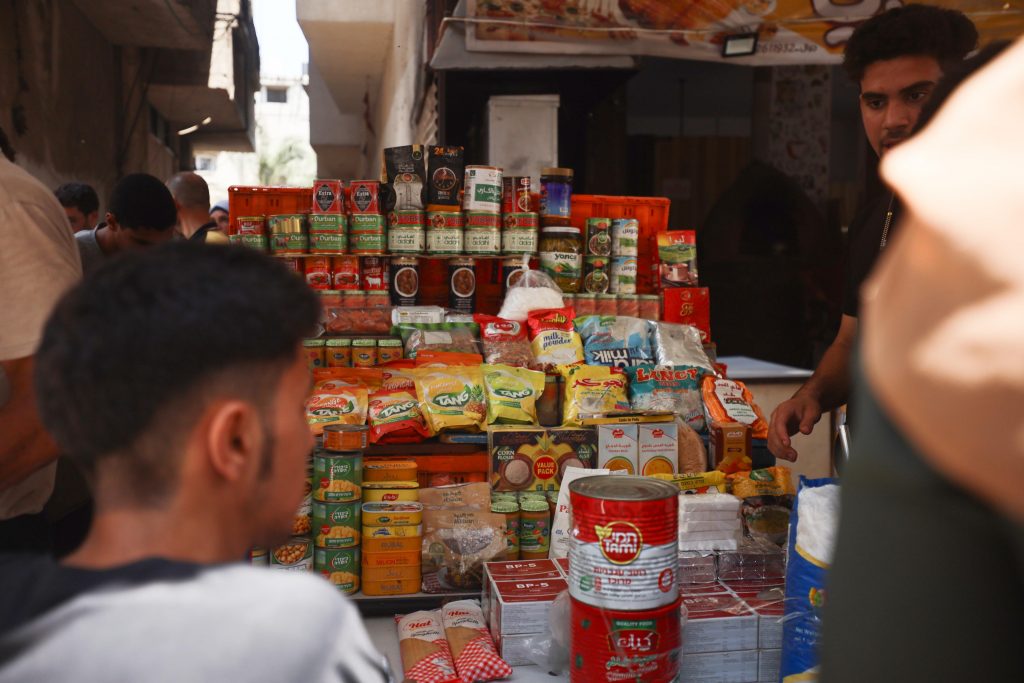
Palestinians look at canned goods in Gaza City’s al-Sahaba market on July 28, 2025. Internationally donated food is sold at inflated prices beyond the affordability of many Palestinians. Photo by TPS-IL
Official Israeli sources explained to TPS-IL that all trucks currently entering Gaza carry humanitarian aid provided by the UN, international NGOs, or donor states — and that Gaza’s private sector is not currently authorized to import goods. The absence of commercial shipments for Gaza merchants raises questions about how donated flour, fruits, vegetables, water, canned goods and more end up in markets with inflated prices.
Palestinian sources inside Gaza told TPS-IL that much of the food in the markets originated from international aid for months — including American shipments — but is resold at inflated prices, sometimes 300%. Basic staples like flour and rice, originally meant for free distribution, are reportedly diverted to private vendors.
“They distribute the aid to traders instead of families,” one Gaza resident told TPS-IL.
Dr. Eyal Ofer, an expert on Gaza’s economy, explained to TPS-IL that “market prices are the core problem fueling Gaza hunger.” He blamed “endless cash being funneled in” by the UN and Palestinian Authority, enabling looting and price inflation.
“Hamas is taking 45% of every UN cash transfer without even touching the aid,” he said. “The people who get the money can afford the inflated prices; those who don’t, starve.”
He added, “I’ve been proposing for a long time is to stop the cash flow. You don’t eat cash.”
Approximately 1,200 people were killed, and 252 Israelis and foreigners were taken hostage in Hamas’s attacks on Israeli communities near the Gaza border on October 7. Of the 50 remaining hostages, around 30 are believed to be dead.

